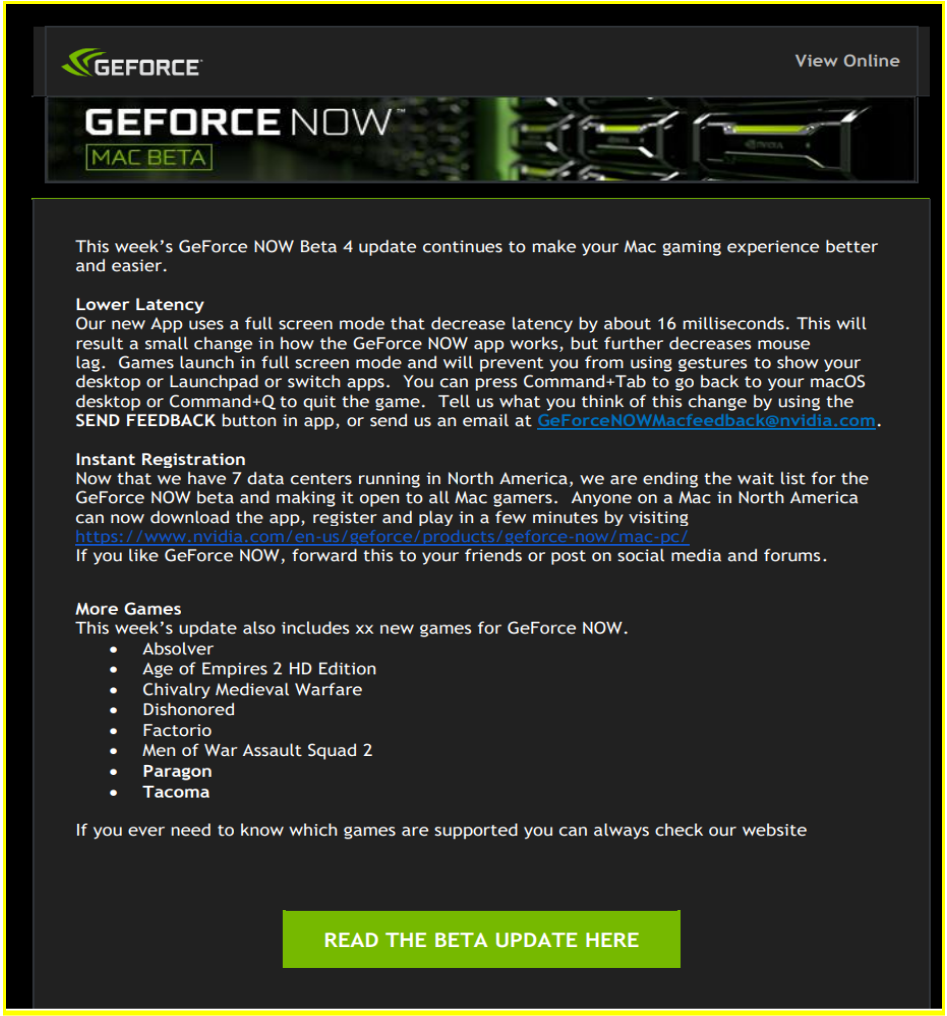With my journalistic background, I was tasked with authoring, editing, refining, proofing, and iterating a variety of copy as a Product Marketing Manager at NVIDIA. This included everything from email blasts to press releases to white papers and product messaging for the web.
I worked mostly on the 3D Vision and GeForce NOW product lines but was often brought in to help with content for a variety of GeForce product teams. I also worked with the engineering teams to refine UI string copy and ensure our app messaging was consistent with the GeForce NOW brand.
What you see here are just a few examples of the types of content I authored and/or assisted with.
NVIDIA GeForce Gaming Thunders Down From the Cloud
GeForce Grid Enables Service Providers to Stream
Even the Most Advanced Games to Any Connected Device
SAN JOSE, Calif.—GPU Technology Conference—May 15, 2012—Computer gaming enters a new era today with the launch of the NVIDIA GeForce Grid™ Cloud Gaming Platform, which allows game-service providers to stream next-generation games to virtually any device, without the lag that hampers current offerings.
With GeForce Grid, gaming-as-a-service providers can deliver the most advanced visuals with lower latency – while incurring lower operating costs, particularly related to energy usage. Gamers benefit from the ability to play the latest, most sophisticated games on any connected device.
“Gamers will now have access to seamlessly play the world’s best titles anywhere, anytime, from phones, tablets, TVs or PCs,” said Phil Eisler, general manager of Cloud Gaming at NVIDIA. “GeForce Grid represents a massive disruption in how games are delivered and played.”
The key technologies powering the new platform are NVIDIA GeForce Grid processors with dedicated video engines and fast streaming technology. Together, they fundamentally change the economics and experience of cloud gaming, enabling game-service providers to operate scalable data centers at user costs that are in line with those of movie-streaming services.
NVIDIA GeForce Grid Processor
Using the highly efficient NVIDIA Kepler architecture, NVIDIA GeForce Grid processors minimize power consumption by simultaneously encoding up to eight game streams. This allows gaming-as-a-service providers to cost-effectively scale their service offerings to support millions of concurrent gamers.
Featuring two Kepler-based GPUs, each with its own encoder, the processors have 3,072 CUDA cores and 4.7 teraflops of 3D shader performance. This enables game-service providers to render highly complex games in the cloud and encode them on the GPU, rather than the CPU, allowing their servers to run more concurrent game streams. Server power consumption per game stream is also reduced to about one-half of previous implementations, an important metric for data centers.
Fast Streaming Technology
Fast streaming technology reduces server latency to as little as 10 milliseconds – less than one-tenth the duration of a human blink – by capturing and encoding a game frame in a single pass. It utilizes fast-frame capture, concurrent rendering and single-pass encoding to achieve ultra-fast game streaming.
The technology also helps GeForce Grid processors to effectively eliminate the actual distance between the gamer and the supercomputer driving the game. Even when that distance is many miles, across a LAN or WAN network, lightning-fast play is now possible.
-END-
Edge Gravity by Ericsson Becomes NVIDIA GeForce NOW Solution Partner
Edge Gravity partners with NVIDIA to bring GeForce NOW Cloud Gaming Service to new and emerging markets
SANTA CLARA, Calif. & BARCELONA – Feb. XX, 2020 – Today, Edge Gravity by Ericsson announced it has become an NVIDIA GeForce NOW Solution Partner. Edge Gravity, a wholly owned subsidiary of Ericsson’s Technology and Emerging Business Unit, is a leader in delivering 5G and edge cloud compute solutions worldwide. As a GeForce NOW Solution Partner, Edge Gravity will help make NVIDIA’s PC game streaming service available in new markets with select global telecom companies.
NVIDIA GeForce NOW makes it possible to play today’s most demanding PC games on devices that would otherwise be unable to run them, such as under-powered laptops, MacOS-based computers, and Android-based smartphones. Edge Gravity’s expertise in working with 5G network providers to enable latency-sensitive, highly interactive applications will help ensure GeForce NOW reaches even more gamers, while providing an exceptional level of performance across an array of edge-connected devices.
GeForce NOW Solution Partners provide telecommunications companies with integration, support and financial services for NVIDIA’s RTX Servers and GeForce NOW cloud gaming system software. Edge Gravity is a world leader in 5G networks and has extensive telecom cloud experience with their Edge Cloud platform.
“GeForce NOW will enable millions of new gamers around the world to play AAA PC games with their friends,” said Phil Eisler, VP/GM of GeForce NOW cloud gaming at NVIDIA. “Edge Gravity will help accelerate the deployment of GeForce NOW through their edge cloud expertise and telco integration services.”
Kyle Okamoto, CEO of Edge Gravity, said, “5G is driving the next wave of innovation. We believe the greatest opportunity for service providers to deliver on the promise of 5G is to participate in the global edge cloud, a new internet architecture designed to enable applications like cloud gaming that demand low latency along with high performance and availability. Our partnership with NVIDIA gives service providers access to new revenue streams while meeting the demands of their customers for new entertainment experiences.”
Attendees are invited to come see a demo of GeForce NOW game streaming on various edge-connected devices at Edge Gravity by Ericsson’s booth. In addition, Edge Gravity is working with Vodafone to provide live demonstrations of GeForce NOW game streaming over a 5G network to 5G enabled devices in their respective booths. These events will occur four times each day and will feature two gamers, one at each booth, competing against each other. The gaming session will be rendered in real time over a 5G connection from a datacenter close to Barcelona.
-end-

